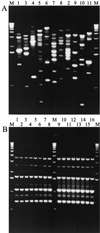Citrobacter rodentium, the causative agent of transmissible murine colonic hyperplasia, exhibits clonality: synonymy of C. rodentium and mouse-pathogenic Escherichia coli
- PMID: 11101562
- PMCID: PMC87603
- DOI: 10.1128/JCM.38.12.4343-4350.2000
Citrobacter rodentium, the causative agent of transmissible murine colonic hyperplasia, exhibits clonality: synonymy of C. rodentium and mouse-pathogenic Escherichia coli
Abstract
Citrobacter rodentium (formerly Citrobacter freundii biotype 4280 and Citrobacter genomospecies 9) was described on the basis of biochemical characterization and DNA-DNA hybridization data and is the only Citrobacter species known to possess virulence factors homologous to those of the human pathogens enteropathogenic Escherichia coli and enterohemorrhagic E. coli. These virulence factors are encoded on the locus of enterocyte effacement (LEE), a pathogenicity island required for the characteristic attaching and effacing (AE) pathology seen in infection with these three pathogens. C. rodentium, which apparently infects only mice, provides a useful animal model for studying the molecular basis of AE pathology. No work has been done to assess differences in pathogenicity between C. rodentium isolates from diverse sources. Here, we report the examination of 15 C. rodentium isolates using a battery of genetic and biochemical approaches. No differences were observed between the isolates by repetitive-element sequence-based PCR analysis, biochemical analysis, and possession of LEE-specific virulence factors. These data suggest that members of the species are clonal. We further characterized an atypical E. coli strain from Japan called mouse-pathogenic E. coli (MPEC) that, in our hands, caused the same disease as C. rodentium. Applying the same battery of tests, we found that MPEC possesses LEE-encoded virulence factors and is indistinguishable from the previously characterized C. rodentium isolate DBS100. These results demonstrate that MPEC is a misclassified C. rodentium isolate and that members of this species are clonal and represent the only known attaching and effacing bacterial pathogen of mice.
Figures





References
-
- Barthold S W, Coleman G L, Bhatt P N, Osbaldiston G W, Jonas A M. The etiology of transmissible murine colonic hyperplasia. Lab Anim Sci. 1976;26:889–894. - PubMed
-
- Barthold S W, Coleman G L, Jacoby R O, Livstone E M, Jonas A M. Transmissible murine colonic hyperplasia. Vet Pathol. 1978;15:223–236. - PubMed
-
- Barthold S W, Osbaldiston G W, Jonas A M. Dietary, bacterial, and host genetic interactions in the pathogenesis of transmissible murine colonic hyperplasia. Lab Anim Sci. 1977;27:938–945. - PubMed
-
- Brennan P C, Fritz T E, Flynn R J, Poole C M. Citrobacter freundii associated with diarrhea in laboratory mice. Lab Anim Care. 1965;15:266–275. - PubMed
-
- Brenner D J, Grimont P A D, Steigerwalt A G, Fanning G R, Ageron E, Riddle C F. Classification of citrobacteria by DNA hybridization: designation of Citrobacter farmeri sp. nov., Citrobacter youngae sp. nov., Citrobacter braakii sp. nov., and three unnamed genomospecies. Int J Syst Bacteriol. 1993;43:645–658. - PubMed
Publication types
MeSH terms
Grants and funding
LinkOut - more resources
Full Text Sources
Medical
Molecular Biology Databases

